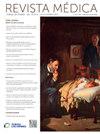肉芽肿病合并多血管炎和神经内分泌肠肿瘤:一个独特而具有挑战性的病例报告
IF 0.2
Q4 MEDICINE, GENERAL & INTERNAL
引用次数: 0
摘要
我们报告一例43岁男性吸烟者谁提出了以皮肤病变类似脓皮病的下肢,点状和坏死的数字溃疡,发烧,不适,多关节痛和炎症标志物升高急诊科。他后来出现双侧无症状的空洞性肺结节、弥漫性肺泡出血、全鼻窦炎和PR3-ANCA阳性,确定了GPA的诊断。采用脉冲甲基强的松龙、口服强的松龙、静脉脉冲环磷酰胺和高压氧治疗(HOT)观察到良好的初始反应。然而,三个月后,他被诊断出患有小肠NET。它是息肉样和多灶性的,儿茶酚胺含量高,但Ki-67含量低,导致免疫抑制治疗减少。出现两个新的急性发作,累及皮肤、肾脏、眼部、肠道和关节,同时伴有c-ANCA水平升高,促使采用利妥昔单抗、血浆置换、皮质类固醇和HOT的再诱导策略,结果显著改善。除了该病例的复杂和具有挑战性的临床管理外,还强调了这种独特的组合- GPA和NET。本文章由计算机程序翻译,如有差异,请以英文原文为准。
Granulomatosis with polyangiitis and neuroendocrine intestinal tumor: a unique and challenging combination in a case report
We report the case of a 43-year-old male smoker who presented to the emergency department with skin lesions resembling pyoderma on the lower extremities, punctate and necrotic digital ulcers, fever, malaise, polyarthralgia and elevated inflammatory markers. He later developed bilateral, asymptomatic cavitary pulmonary nodules, diffuse alveolar hemorrhage, pansinusitis, and positive PR3-ANCA, establishing the diagnosis of GPA. An excellent initial response was observed with pulse methylprednisolone, oral prednisolone, intravenous pulse cyclophosphamide, and hyperbaric oxygen therapy (HOT).
Three months later, however, he was diagnosed with a NET of the small intestine. It was polypoid and multifocal, with high catecholamine production but low Ki-67, leading to a reduction in immunosuppressive therapy. Two new flares occurred, with skin, renal, ocular, intestinal, and joint involvement, along with elevated c-ANCA levels, prompting a reinduction strategy with rituximab, plasmapheresis, corticosteroids, and HOT, resulting in significant improvement.
In addition to the complex and challenging clinical management of this case, this unique combination – GPA and NET – is highlighted.
求助全文
通过发布文献求助,成功后即可免费获取论文全文。
去求助
来源期刊

Revista Medica Clinica Las Condes
MEDICINE, GENERAL & INTERNAL-
CiteScore
0.80
自引率
0.00%
发文量
65
审稿时长
81 days
 求助内容:
求助内容: 应助结果提醒方式:
应助结果提醒方式:


